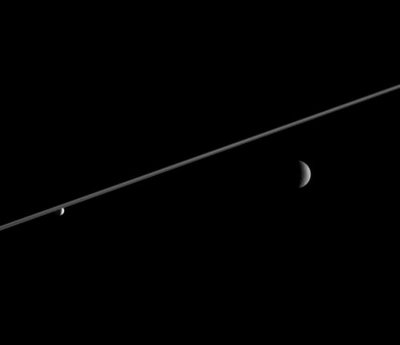Monday, March 13, 2006
Pristine and Not So Pristine
 Pretty picture of the day: Enceladus (left) and Rhea (right) imaged with Saturn's edge-on rings. This gives you a good comparison between Enceladus and its larger sister.
Enceladus is bright because of resurfacing of water from pools just a few dozen feet beneath the surface of its southern hemisphere. Reflectivity is up around 90%, just like pure ice. Or just like this psalm passage:
Pretty picture of the day: Enceladus (left) and Rhea (right) imaged with Saturn's edge-on rings. This gives you a good comparison between Enceladus and its larger sister.
Enceladus is bright because of resurfacing of water from pools just a few dozen feet beneath the surface of its southern hemisphere. Reflectivity is up around 90%, just like pure ice. Or just like this psalm passage: Cleanse me with hyssop, that I may be pure;
wash me, make me whiter than snow. (51:9)
Rhea is more like that roadside stuff a few weeks after the last snowfall. Vehicle emissions have rendered it gray-brown to black, and you get a landscape something like this over here on the right >>>
Interesting that carbon compounds might also be one of the coloring/darkening agents in the outer solar system as they are on our winter streets. When I was a kid, I was fascinated by the cross-sections cut by the street plow. I used to look for layers of snow and dirt alternating. During those cold northern winters, sometimes I could trace the layers up to four snowfalls into the past.
At 325 degrees below zero, ice acts very much like rock, but there are some differences. We see a curious geology at work in the outer solar system. God's creation will contain many, many more cold little worlds like this than like our own. Many of the ones in our own solar system seem distinctive and unique -- a far cry from the expected lifeless ice cubes we expected. Leads me to think we might have missed something important on our own moon the first time we were there.
Cleanse me with hyssop, that I may be pure;
wash me, make me whiter than snow. (51:9)
Rhea is more like that roadside stuff a few weeks after the last snowfall. Vehicle emissions have rendered it gray-brown to black, and you get a landscape something like this over here on the right >>>
Interesting that carbon compounds might also be one of the coloring/darkening agents in the outer solar system as they are on our winter streets. When I was a kid, I was fascinated by the cross-sections cut by the street plow. I used to look for layers of snow and dirt alternating. During those cold northern winters, sometimes I could trace the layers up to four snowfalls into the past.
At 325 degrees below zero, ice acts very much like rock, but there are some differences. We see a curious geology at work in the outer solar system. God's creation will contain many, many more cold little worlds like this than like our own. Many of the ones in our own solar system seem distinctive and unique -- a far cry from the expected lifeless ice cubes we expected. Leads me to think we might have missed something important on our own moon the first time we were there.